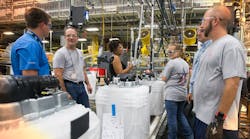With lean, understanding what you did is one thing, but understanding why—both the rationale and what you expected to get from it—is the important takeaway.
Failing to explore this runs the risk of implementing the lean “tools” without any understanding of the overriding business strategy, or how the tools work together and what kind of results you should expect.
Unfortunately, I think we are still mired in the “tools” phase of lean at most companies today. This type of thinking drives over 90% of the companies that go down the lean path to see it as just a cost reduction program. This, of course, all but guarantees that they will never become a lean enterprise.
Time with the Presidents
When I was a group executive at Danaher Corp. working on lean, we created the “Presidents kaizen” to engage our leaders and to spread lean learning.
We had started aggressive kaizen efforts at two of my group companies, Jacobs Chuck and Jacobs Brake (Jake Brake). We were using the Shingijutsu consultants (three ex-Toyota executives who had all worked for Taiichi Ohno implementing the Toyota Production System in the Toyota Group companies and in first-tier suppliers) and were making great progress, especially at Jake Brake. We were having the usual results: large productivity gains, much better quality, shorter lead times, freeing up floor space and, of course, rapid reductions in inventory.
Great. Of course, with standard cost accounting, the rapid inventory decline was making our earnings look worse. This concerned the corporate finance team and resulted in an “emergency” visit by the Rales brothers, who were the majority owners of Danaher.
Oh, oh! What to do? George Koenigsaecker, then president of Jake Brake, and I decided that just taking them to the conference room and reviewing the numbers was probably a big loser for us. We needed to show them results on the shop floor first. George K. set up the tour and made the brilliant decision to have it conducted by our UAW associates. We spent about three hours on the floor, and when we got back to the conference room, there was no need for a financial review. All the Rales brothers said was, “How fast can you do this in the rest of the Danaher companies?” (There were a total of 13 companies at that time.)
Well, we were still employed, but now we faced the issue of how to spread lean through the other 11 companies. We first asked Shingijutsu to help us, but they said no. They felt Chuck and Brake were so bad that they wanted to see them improve first.
Now, at that time both George K. and I saw lean as the greatest strategic weapon any company could have. We also understood that it was so totally different from the traditional approach that all our companies were using, that it had almost no chance of being implemented—and more importantly having the improvements stick unless it was driven from the top by the Danaher Presidents.
With that as our principal rationale, we organized the first President's kaizen, with the help of John Cosentino (the other Group executive at the time). Our first step was to take all 13 presidents and their VPs of operations to Japan for a week, to observe lean at a high level. I think we visited eight different companies that week. When we got back Cosentino and I basically ordered all our presidents to participate in a three-day kaizen, every six weeks, at one of our plants. We wanted them to see and experience just how much gain could occur in a few days using the lean approach. We wanted to put them in a position where, when they went back to their own companies, they could overcome the objections from their own staff that they were bound to encounter: “Wait a minute, I know we can do this because I just saw it done at XYZ company during our last Presidents kaizen.”
Well, as you might expect, lots of bitching at first. “Hey, I’m a president of a company, why do I need to spend three days in my blue jeans working on someone else’s shop floor?” But there is no other way. Lean is a “learn by doing” activity, and we were in effect forcing them to learn and understand the opportunities.
We moved a lot of equipment, created new cells and got big gains. One of our first teams reviewed a request for a new paint line that was to cost $750,000 and was in the final stages of approval. The team found that not only did we not need to spend $750,000; there was an additional 50% capacity available on the existing paint line. Cha-ching! Another team moved a bunch of equipment and created a one-piece-flow line that could produce the same quantity with three people that they were using 14 people for. You can’t just ignore gains like this.
Guess what? After about three of these kaizens, the bitching stopped and the presidents were arranging their calendars to make sure that they didn’t miss the next one. Even though none of the then-13 Danaher companies had any overlapping business, the presidents started to build relationships with each other. We started to build a culture of kaizen in Danaher. When Shingijutsu was finally ready to help the other companies, there was no resistance and we started to see results. This in effect was part of the early foundation of the Danaher Business System.
Sharing the Knowledge
When I moved on to become CEO of Wiremold, I continued this same practice, with two to four such events each year involving the presidents of our subsidiary companies and my senior staff. It was great for team-building. We eliminated a lot of waste that we never even targeted just because of the mix of functions we had on each team. For example, we put sales and marketing people on setup teams. The team would discover that it was taking 1-2 hours to change from size A to size B, which was very low volume and almost the same functionally as A. The marketing and sales guys on the team would say, “Gee, I didn’t even realize we were offering B, which we don’t need—so let’s eliminate it.” Boom, we saved 1-2 hours of wasted setup time, simplified the product offering, provided shorter lead times and lowered the cost just by having mixed management teams.
How you build your kaizen teams spills over into your day-to-day activity even when you are not having a President’s kaizen. You are trying to create a learning environment where every employee can learn to see the waste and contribute ideas of how to eliminate it. I’ve found that the best way to do this is to conduct a great deal of kaizen activity. Roughly half of your teams should be formed with hourly employees, and roughly half with salaried employees. The best ideas will come from the people doing the work. On the salary side, having people from different functions on a team can help bring unexpected gains.
At Wiremold, we had our field salesforce participate in kaizen on the shop floor early on. We wanted them to understand what they put the organization through when they had unreasonable demands. Just as importantly, we wanted them to go back and brag to their customers about the great things Wiremold was doing (which they did, by the way).
So, whether you do a President's kaizen or a senior staff type of kaizen, remember that in addition to the gains you will get in the kaizen, you will get a lot of “learn by doing” gains among the people who you need to drive lean forward. You will not only build great teamwork but start to build the learning environment necessary to become a lean enterprise. Try it; you’ll like it.
Art Byrne is an operating partner with J.W. Childs Associates, a private equity firm specializing in leveraged buyouts and recapitalizations of middle-market growth companies, where he leads the implementation of lean management at Childs' portfolio companies. He has implemented lean principles in more than 30 companies, including as a general manager at GE, group executive at Danaher and CEO of Wiremold.
This article originally appeared in the Lean Enterprise Institute’s blog, and is used with permission.




